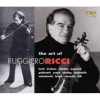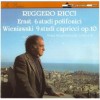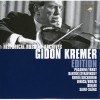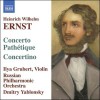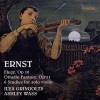| Country: | Austria |
| Period: | Romantique |
Biography
Heinrich Wilhelm Ernst (b. June 8, 1812? (erroneously May 6, 1814), Brünn – October 8, 1865, Nice) was a Moravian-Jewish violinist, violist and composer. Ernst was widely seen as the outstanding violinist of his time and one of Paganini's greatest successors.
Most articles concerning Heinrich Wilhelm Ernst say he was born on 6 May 1814. Rowe, in his 2008 work, concluded that this date could be not correct. The pressure, as a prodigy, to be young, coupled with the absence of a birth certificate and unreliability of the marriage certificate, makes Rowe think that Ernst was actually born on 8 June 1812, and was therefore nearly two years older than is normally thought.
Ernst was born in Brno, Moravia. At the age of 9, he began to study violin. Ernst was a child prodigy, educated at the Vienna Conservatory of the Gesellschaft der Musikfreunde, studying violin under Joseph Böhm, starting in 1825, and Joseph Mayseder, and composition under Ignaz von Seyfried.
In 1828, Paganini visited Vienna. Ernst heard him and was deeply impressed by his violin playing. It's said that Ernst then played for Paganini who predicted a brilliant career for him. Paganini gave 14 concerts in Vienna, and Ernst attended many of these to observe the master. In April 1829, Ernst left Vienna for Munich for an employment in the royal orchestra, but Paganini advised him to aim for something higher. After that, Ernst played concerts in the same cities as Paganini. These concerts were appreciated, but he still stood in Paganini's shadow. This depressed him to the degree that he locked himself into his room for five days. Later in Frankfurt in the spring of 1830, Ernst met Paganini again. There, Ernst gave a concert where he played Paganini's Nel cor pìù non mi sento with an accuracy that stunned both the audience and Paganini himself. This work, as with most of Paganini's compositions, was unpublished at that time, which meant that Ernst must have learned it by ear at Paganini's concerts. Some days after, Ernst visited Paganini, who was sitting composing on his guitar. Paganini immediately rose up, threw the manuscript under the bed sheet, and said that he had to protect his composition not only from Ernst's ears, but also his eyes.
In the following years, Ernst made several tours through France. When he heard that Paganini was to play concerts in Marseille in January 1837, he went there to hear his master again. Ernst was determined to learn the secrets of Paganini's complex technique. With help from relatives of his secretary, he rented a room next to Paganini's. He hid there day and night, listening to Paganini rehearse and writing down what he heard. That must have been difficult, because Paganini did not practice much during his tours, and when he did, he used a mute. Ernst also managed, secretly, to attend all of Paganini's rehearsals in Marseille in pursuit of his goal. Ernst too played concerts in Marseille and managed to get these and the concerts Paganini played to become some sort of competition between the two. He managed to organize two concerts before Paganini arrived, and these concerts were well appreciated by the audience. Then, when Paganini was about to play his first concert, the demands on him were greater because of the comparison to Ernst's playing. Paganini couldn't meet the demands of the audience who thought that Ernst's playing had spoken more to the heart. Paganini then organized another concert and challenged the audience by playing his Moïses, variations on the G string, moving some to tears. After that concert, opinions were divided. Some said Paganini mastered the difficulties better, but Ernst played with more sentiment. Ernst learned this composition through the wall from his room next to Paganini.
Perhaps out of respect for Paganini, Ernst later composed his own set of variations on the theme Carnaval de Venise, which he often played at the end of his concert. He also used scordatura in the same manner as Paganini did in his variations. This piece was most popular among Ernst's audience everywhere where he played, and it became his signature. All his professional life, he was on tour around Europe playing concerts and also composed many violin pieces and formed his own style.
Ernst also played the viola. He performed the solo viola part of Berlioz's Harold en Italie multiple times, the first in September 1842 in Brussels under the direction of the composer. After 1844 he lived chiefly in England. He joined the Beethoven Quartet Society in London, where he chiefly played Beethoven String quartets with Joseph Joachim, Henryk Wieniawski and Alfredo Piatti.
In 1862, his health failed from neuralgia of a most severe kind, which made him unable to play. He spent the last seven years of his life in retirement, chiefly in Nice, where he spent time composing, e.g., the Polyphonic Studies. Ernst died in Nice.
Though Ernst was a highly esteemed artist in his days, he is not well known today. Many saw him as the superior violinist of his time and Paganini's greatest successor. Not only did he contribute to polyphonic playing, but he also discovered new idiomatic ways to compose polyphonically conceived violin music. His friends included Hector Berlioz and Felix Mendelssohn.





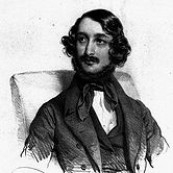

![Russian legends - Gidon Kremer [10 CD]](http://static.classicalm.com/repository/collection-cover/small/273-img1318873589669975.jpg)
